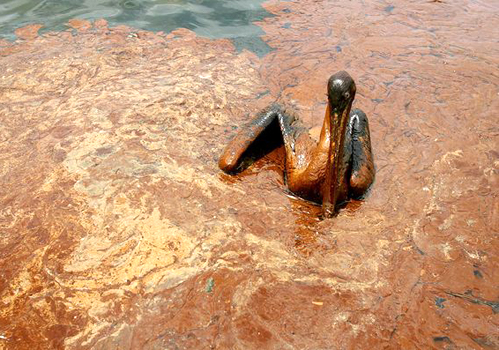

Greg Palast

Yesterday, Ecowatch.org revealed that, in September 2008, nearly two years before the Deepwater Horizon explosion in the Gulf of Mexico, another BP rig had blown out in the Caspian Sea—which BP concealed from U.S. regulators and Congress.
Had BP, Chevron, Exxon or the Bush State Department revealed the facts of the earlier blow-out, it is likely that the Deepwater Horizon disaster would have been prevented.
Days after the Deepwater Horizon blow-out, a message came in to our offices in New York from an industry insider floating on a ship in the Caspian Sea. He stated there had been a blow-out, just like the one in the Gulf, and BP had covered it up.
To confirm this shocking accusation, I flew with my team to the Islamic republic of Azerbaijan. Outside the capital, Baku, near the giant BP terminal, we found workers, though too frightened to give their names, who did confirm that they were evacuated from the BP offshore platform as it filled with explosive methane gas.
Before we could get them on camera, my crew and I were arrested and the witnesses disappeared.
Expelled from Azerbaijan, we still obtained the ultimate corroboration: a secret cable from the U.S. Embassy to the State Department in Washington laying out the whole story of the 2008 Caspian blow-out.
The source of the cable, classified “SECRET,” was a disaffected U.S. soldier, Private Bradley Manning who, through WikiLeaks.org, provided hot smoking guns to The Guardian.
The information found in the U.S. embassy cables is a block-buster.
The cables confirmed what BP will not admit to this day: there was a serious blow-out and its cause was the same as in the Gulf disaster two years later—the cement (“mud”) used to cap the well had failed.
Bill Schrader, President of BP-Azerbaijan, revealed the truth to our embassy about the Caspian disaster:
“Schrader said that the September 17shutdown of the Central Azeri (CA) platform…was the largest such emergency evacuation in BP’s history. Given the explosive potential, BP was quite fortunate to have been able to evacuate everyone safely and to prevent any gas ignition. … Due to the blowout of a gas-injection well there was ‘a lot of mud’ on the platform.”
From other sources, we discovered the cement which failed had been mixed with nitrogen as a way to speed up drying, a risky process that was repeated on the Deepwater Horizon.
Robert F. Kennedy Jr., president of Waterkeeper Alliance and senior attorney for Natural Resources Defense Council, calls the concealment of this information, “criminal. We have laws that make it illegal to hide this.”
The cables also reveal that BP’s oil-company partners knew about the blow-out but they too concealed the information from Congress, regulators and the Securities Exchange Commission. BP’s major U.S. partners in the Caspian Sea drilling operation were Chevron and Exxon.
The State Department got involved in the matter because BP’s U.S. partners and the Azerbaijani government were losing more than $50 million per day due to the platform’s shutdown. The Embassy cabled Washington:
“BP’s ACG partners are similarly upset with BP’s performance in this episode, as they claim BP has sought to limit information flow about this event even to its ACG partners.”
Kennedy is concerned about the silent collusion of Chevron, Exxon and the Azerbaijani government. “The only reason the public doesn’t know about it is because the Azerbaijani government conspired with them to disappear the people who saw it happen and then to act in concert, in collusion, in cahoots with BP, with Exxon, with Chevron to conceal this event from the American public.”
Kennedy’s particular concern goes to the connivance of the State Department, then headed by Secretary of State Condoleezza Rice, in the cover-up and deception. Chevron, noted Kennedy, named an oil tanker after Rice who had served on the oil company’s board of directors. “BP felt comfortable—and Chevron and Exxon—in informing the Bush State Department, which was run by Condoleezza Rice,” he said, “and they felt comfortable that that wasn’t going to come out.”
The U.S. Securities Exchange Commission requires companies to report “material” events. BP filed a “20-F” report in 2009 stating, “a subsurface gas release occurred below the Central Azeri platform,” suggesting a naturally occurring crack in the seafloor, not a blow-out. This contradicted the statements of three eyewitnesses and the secret statement of BP’s Azerbaijan President in then WikiLeaks cable.
“The three big actors, Chevron, Exxon and BP all concealed this from the American public,” concludes Kennedy. “This is a criminal activity.”
And why would the Azerbaijan government cover up a disaster costing it $40 million to $50 million a day? According to another insider, Les Abrahams, it has to do with at least $75 million in bribes that he paid to Azeri officials in Baku.
Abrahams was a BP executive in Baku in the 1990s working simultaneously, at BP’s insistence, with MI6, British intelligence. We met with Abrahams in London who told us he was joined in his payoff runs by BP’s CEO and Chairman Lord Browne who insisted on handing over a “sweetener” himself.
BP refused to be interviewed for this investigation, but did answer our questions in writing. The company will neither confirm nor deny the 2008 Caspian Sea blow-out. As to the failure to tell Congress and US regulators and the SEC about the blow-out, BP states only that it informed the government and regulators of Azerbaijan. However, the company does implicate its partners (Chevron and Exxon). BP states it, “shared the facts of its investigation with the Azerbaijan government, regulators, partners and within BP.”
In response to further questions, BP does not deny the payment of bribes to Azerbaijan officials by company executives. It should be noted that at the time, that, unlike under U.S. law, Britain had not made bribery of foreign officials a crime.
——–
Re-prints permitted with credit to EcoWatch.org and the author.
Greg Palast is the author of Vultures’ Picnic (Penguin 2011), which centers on his investigation of BP, bribery and corruption in the oil industry. Palast, whose reports are seen on BBC-TV and Britain’s Channel 4, will be providing investigative reports for EcoWatch.org.

 233k
233k  41k
41k  Subscribe
Subscribe 